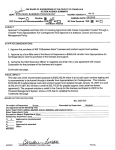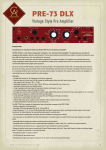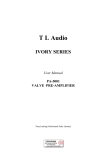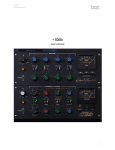Download Comp-54 manual - Golden Age Music
Transcript
COMP-54 Vintage Style Compressor INTRODUCTION Congratulations on choosing the Golden Age Project COMP-54 Compressor! The COMP-54 is a one-channel vintage style compressor. The signal path uses only discrete components like resistors, capacitors and transistors. The input and output are transformer balanced and the unit also uses a third interstage transformer. This is the way audio components were built before integrated circuits became available. IC´s are small and cheap and they are widely used in most modern designs. It is clear though that audio components built with modern technology doesn´t always provide the best perceived sound quality or character that the modern user desires. On the contrary, the subjective sound quality delivered by vintage equipment is often prefered over the one delivered by modern units. This is the reason why so many vintage audio components are cloned and produced again and also why the vintage originals are often very expensive on the second hand market. The class-A circuit used in the COMP-54 is similar to the one in the classic 2254 compressor that was designed in 1969. It quickly became a legend due to it´s totally unique sound character that is warm, smooth, sweet and musical. These characteristics have been heard on countless recordings through the years and it is a versatile sound that works very well on many sound sources and in many genres. The essence of this sound is now available at a surprisingly low cost, making it available to nearly everyone. FEATURES - Vintage style electronics. - Based on classic diode bridge designs. - Transformer balanced I/O´s. - Prepared for transformer upgrade. - Flexible control range for Ratio, Attack and Release. - All controls except the Gain make-up one are stepped. - Three selectable Sidechain filter frequencies. - Separate Bypass and Compression IN/OUT switches. - Meter selectable for Output and Gain Reduction. - Possibility to Link two units for stereo operation. - Separate in- and output XLR and TRS jacks for flexible connections. - Back panel switch for 600 Ohm termination. - External power power supply to avoid interaction with the audio circuitry and the transformers. - Great sound that suits most sound sources and genres. - A solid build quality that will last many years of normal use. W W W . G O L D E N A G E P R O J E C T . C O M I CIRCUIT DESCRIPTION The signal first enters the input transformer, a damping network and is then passed on to the diode bridge where the actual gain reduction is taking place, it is followed by balanced FET-transistor stage. Then follows an interstage stepup transformer that feeds the sidechain circuitry and a three transistor gain stage followed by the GAIN potentiometer. The signal then goes to the output stage. This stage again uses only three transistors, the last one in the chain is a hefty 2N3055 power transistor running in class-A mode, driving the output transformer. So, all in all, the complete signal chain only contains a maximum of ten active elements. Compare that to the big number of transistors that are usually used in one single integrated circuit! MODERN VERSUS OLD It is true that there are some great IC´s available today that achieves very low levels of static and dynamic distortion.The simple circuits that the COMP-54 uses, and even more so the transformers, cannot match the low distortion specifications of modern IC´s. It is the distortion components that imparts a sound character to the audio signal and, if the distortion components are of the right sort, this is a good thing since it makes the recorded voice or instrument sound “better”, more musical, more pleasing to the ear. This is one reason why vintage style units are so popular today. Sometimes, transparent units are prefered over colored ones. It´s all about taste and it depends on the genre. For most modern music styles though, color and character is definitely a good thing. And isn´t it great to use audio components built according to the old, minimalistic approach where one can follow the signal flow from one discrete component to another? USING THE COMP-54 The best way to learn using a compressor is by experimentation. A compressor can be set to do its job, which is to lower the dynamic range of a signal, more or less invisible or it can be used as a creative tool, affecting the sound in a big way. You will find a lot of information about how to use and adjust compressors on the internet. CONNECTING THE COMP-54 Connect the power adaptor to the AC outlet (please note: there are different adaptors used for 115V and 230V) and the 24V AC output to the jack on the back panel. Connect the audio source to any one of the input jacks, XLR or TRS. They are wired in parallell, the same is true for the output jacks. The output stage will easily drive two modern units connected at the same time. Since the unit is transformer balanced, it usually doesn´t matter if you use balanced or unbalanced units before and after it. CONTROLS THRESHOLD: This sets how high the signal must reach before the compressor kicks in. RATIO: This sets how much compression is applied in ratio to the dB rise in signal level above the Threshold. ATTACK: This sets how fast the compressor kicks in once the Threshold has been breached. RELEASE: This sets how fast the compressor lets go, once the input signal has dropped back below the threshold. HPF: This adds a high pass filter in the sidechain circuitry. Frequencies below the filter cut off will trigger compression to a lesser degree. GAIN: This changes the make-up gain so that the ouput level can be adjusted to a suitable level. LINK: Is used to synchronize the compressor action in two COMP-54 units working as a stereo pair. This is usually done to prevent image W W W . G O L D E N A G E P R O J E C T . C O M shifting that could occur if each channel is compressed individually and content on one channel is louder than that on the other. Simply connect an unbalanced TRS-cable between the LINK jacks on the back panels, press the LINK switches and match the controls on both units. IN/OUT: Pressing this switch removes the compression action, the signal still passes through the circuitry though so you can compare the sound with and without compression. METER: Switches the meter to show output level or gain reduction. BYPASS: This is a hardwire bypass, meaning that the signal is directed from the input jacks directly to the output jacks if this switch is pressed. You can then easily compare the sound with or without the COMP-54 in the signal chain. 600 OHM TERM: The output transformer is designed for having a load of 600 ohms. The input impedance of most modern equipment is 10 kohm or more. If the transformer isn´t properly loaded, the output level will increases, the square wave response will worsen and the higher frequencies will be accentuated. So, if you connect the COMP-54 to a modern unit, the switch should normally be engaged so that the output transformer is properly terminated. You can always let your ears decide which position works best, the switch can be used as a two position high frequency eq. LEVELS AND METER CARE Care must be taken to protect the meter from physical overload, not the least when it is set to show output level. If the needle is hitting the end of it´s travel hard or for prolonged periods, there is a risk that the meter will be damaged. This is not covered by warranty. The unit is calibrated from factory to show 0 VU when the output level is about +4 dBu (or 1,23 volts). This is a common reference level in pro audio but most equipment will be able to handle much higher levels. Since the COMP-54 will be used in different setups, it is possible to adjust the meter reference level with the trim potentiometer on the circuit board marked “Meter Out”. If the needle hits the end of its travel, you should adjust the trimmer so that the needle stays within its normal travel, you will then have raised the reference level. If the COMP-54 is used in a semi-professional -10 dBu environment, you can decrease the VU reference level by adjusting the trimmer the other way. Another way to stop the meter needle from hitting the end of it´s range is to switch the meter to show gain reduction since the full scale will usually seldom be reached unless you compress very hard. There is a trim potentiometer also for this meter mode marked “Meter GR”. WARRANTY The COMP-54 come with a one year, parts and labor, limited warranty. It is built to last, but components can break down. There is a slow blow fuse located inside the unit. If the unit dies, please check this fuse. If it has blown, replace it with a new one. If this doesn´t help, the unit will need repair and you should then contact the dealer where you bought the unit. Please note that repairs and warranty issues are handled, through your dealer, by the distributor in the area where you bought the unit. Damages caused by misuse is not covered by warranty. REGISTRATION You are welcome to register your unit at our website: www.goldenageproject.com --------------------------I would like to thank you for chosing the COMP-54! I wish you much joy with the unit and I hope that it will help you in making a lot of great sounding music. Yours, Bo Medin Create music – Be happy! II










